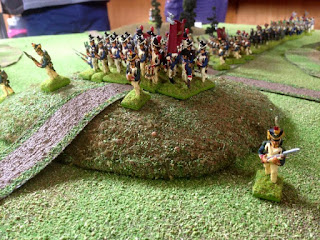The rules themselves, after a few games, seem pretty solid. The movement, shooting, calculation of casualties and such things are all starting to fall into place so that the speed of play has quickened compared to our initial games. The major stumbling block that we came across today (and previously) is Melee Results.
Like shooting, the rules for melee itself are pretty solid but the resulting morale and control tests are confusing. It took us the better part of the final hour of the game to sort out a workable solution which goes like this:
a) - The loser of the melee immediately retires 50mm and takes a morale test. (This is straight from the rules)
b) - In the following turn the results of the Morale test are enacted as a "Compulsory Move" if the result is Retire, Retreat or Rout. (This is something we will introduce as part of a "Turn Sequence" thingy).
c) - Regardless of the result the winner of the melee (in the previous turn) will now take their Control Test. This could result in the winner Retiring, Holding, making a Controlled Advance or Running Amok! (Well, variations on these themes anyway).
But I must say, I'm writing this from memory and our solution may be slightly different. I did take notes but I don't have them on my right now.
Anyway, here's some pics from the game.
Note: my nice new gaming mat that I made during the week!
The Polish brigade advances onto the table and start to shake out.
A couple of well dressed Polish officers chewing the fat overlooking the battlefield.
I finished my first squadron of the Brandenburg Uhlan Regiment.
I also had a troop of three 6pdr guns which made a surprise appearance and helped drive back the Polish battalion on the far right of the picture with some nasty fire down their flank.
Not bad for their debut.
Not bad for their debut.
On the Prussian left, skirmishers from the fusilier battalion of the 8th Leib traded shots with their Polish counterparts. As the main body of the battalion retired due to the deployment of a Polish gun battery, the skirmishers fell back.
The Fusilier battalion continued to retire in order to face toward the Poles emerging from the woods.
Skirmish combat in NCiM can take place a very close ranges. Notice in the second pic below that the fusiliers' number were significantly reduced.
The Poles setting up the melee combat that was to bring the proceedings to a halt.
The Prussians were pushed back. Although casualties on both sides were light, the Prussians, being out front of the main position were unsupported and the morale test resulting from the melee would have had them retreating. What we couldn't work out was when. And what did this mean for the Poles who made a Control Test with the result of Hold or Advance if you so desire.
All very confusing at the time.
I don't seem to have any pics, but on the right my Freiweilliger Jäger did well. They drew in two Polish battalions and, using the cover of the wood, managed to first drive off the Polish voltigeurs and then, with the help of the 6 pdr detachment, force the one of the battalions back.
Well done men!

























































